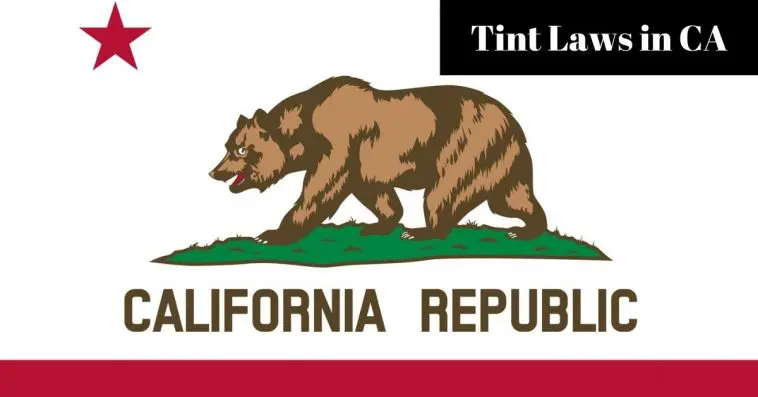If you live in California and you own a car, you may have considered the possibility of tinting your windows. It’s often sunny on the West Coast, and having tinted windows can be a helpful and convenient accessory for your daily driver.
Of course, if this is your first time installing tinted windows on your car, you may be unfamiliar with the various rules and restrictions that the Californian government has set in place regarding window tints.
Today, I’ll be giving you a comprehensive guide to California car window tint laws, so you can safely tint your windows within the legal limits.
TABLE OF CONTENTS
Are You Allowed To Have A Tinted Windshield And Windows In California?
Yes, but there are very specific restrictions for how your windshield and front side windows can be tinted.
Your windshield must remain largely untinted; however, you can install a strip of non-reflective tint at the top of your windshield (although this strip cannot be more than 4 inches wide).
Your front side-windows must have a VLT of 70%. VLT stands for “visible light transmission” and it refers to the percentage of sunlight that is able to make it through your tint.
There are no restrictions on how dark you can tint your back side-windows and rear window, however.
What Is The Darkest Tint You Can Legally Get In CA?
This depends on what windows you want to tint. If you’re just trying to tint your back side-windows and rear window, there are no restrictions on how dark you can have your tint; you can even install tint with a VLT of 5% if that’s what you want.
If you do tint your rear window, your car must be equipped with dual side-mirrors; this shouldn’t be a problem for most drivers, since modern regulations require all cars made today to have dual side mirrors.
Some older cars were only made with a side-mirror on the driver’s side, however, so if you own such a car, then keep this window tint regulation in mind.
For your windshield and front side windows, the tint must not be so dark as to obscure the driver, which is why tint regulations are more restrictive for these windows.
Is 20% Tint Illegal In CA?
Again, this is dependent on what windows you’re tinted. For windshields, any kind of tint is illegal except for the transparent strip of tint at the very top. For front side-windows, any window tint with a VLT of less than 70% is illegal.
By no means are I suggesting you tint your windshield, since applying anything more than the aforementioned strip of tint is illegal.
However, I feel it’s worth mentioning that a heavily tinted windshield can also be a safety hazard; tinting your windows makes it harder to see out of them at night, and if the VLT of your windshield is below 20%, it can effectively leave you driving blind during nighttime hours.
Can You Get Pulled Over For Tinted Windows In California?
Getting pulled over is definitely a possibility if your windows are too dark. However, it’s important to remember that having illegally-tinted windows does not grant the police the automatic right to search your vehicle.
Unless the officer has probable cause to search your vehicle or you happen to have contraband in plain sight within your vehicle when you get pulled over, you are entirely within your legal rights to deny an officer permission to search your car.
How Much Is A Tint Ticket In CA?
This largely depends on the type of ticket you are issued if you happen to get pulled over.
If it’s your first time getting pulled over for anything, you can expect to get away with a pretty lenient fine; in California, the standard fine for having illegally-tinted windows is only $25.
However, if you’ve been pulled over before for similar reasons, you may be charged with an infraction, which is more serious and comes with a much heftier fine. If you do end up charged with an infraction, you can expect to pay a fine of $197.
Additionally, you may be issued a simple “fix-it” ticket, which will simply require you to remove the tint. You’ll then need an officer to verify that the tint was removed, or you may have to verify this yourself by filing an affidavit.
Or, you may be issued a standard ticket; this is more likely to happen if you’ve already received a ticket for illegally-tinted windows and didn’t comply with the request to remove your tint.
In this case, you’ll likely have to appear in court and provide a justification for why you didn’t remove your window tint the first time you were asked.
In any case, having to deal with the legal repercussions of illegally tinting your windows is always going to be a pain, so save yourself the trouble and just make sure your windows are tinted within the legal limits from the get-go.
Window Tint Darkness In California
We’ve already gone over the restrictions on window tints in greater detail, but here we’re just going to quickly summarize what we’ve discussed so far.
We’ll also take this opportunity to clarify the difference between passenger vehicles and MPVs (multi-purpose vehicles). Passenger vehicles include sedans, coupes, convertibles, hatchbacks, and station wagons.
Essentially, a “passenger” vehicle is any vehicle designed to carry passengers that doesn’t include third-row seating, a cargo bed, or an oversized cargo area.
In contrast, MPVs include SUVs, minivans, pickup trucks, panel vans, crossovers, and RVs.
An MPV, therefore, can be defined as a vehicle designed to carry over 5 passengers, a vehicle that is intended primarily for utility purposes, or vehicles like RVs that contain an integrated living space.
If you’re unsure of whether or not your vehicle is designated as a passenger vehicle or as an MPV, then you can find out by checking the Federal ID label.
This label can be found on the driver’s side door frame, and it should clearly state what type of vehicle your car is classified as.
For Passenger Vehicles
- Windshields may have a strip of non-reflective tint at the top; this strip may not be wider than 4 inches
- Front side-windows must not be tinted to a VLT of less than 70%
- Back side-windows have no restrictions on how dark the tint can be
- Rear windows have no restrictions on how dark the tint can be
For MPVs
- Windshields may have a strip of non-reflective tint at the top; this strip may not be wider than 4 inches
- Front side-windows must not be tinted to a VLT of less than 70%
- Back side-windows have no restrictions on how dark the tint can be
- Rear windows have no restrictions on how dark the tint can be
Window Tint Reflection In California
We’ve covered the basics of laws regarding the darkness of your window tint, but we have yet to go over what the laws state regarding reflectivity.
A more reflective window reduces heat and glare inside your car, but it can also be a safety hazard for other drivers; if your window is too reflective, you can easily blind oncoming drivers.
Currently, the state of California does not allow any kind of tinted windows that are more reflective than what comes standard with your car.
Any kind of colored tint is also illegal on any type of car. In previous years, the state of California allowed drivers to install colored tint on their car windows; however, present-day regulations prevent the use of any type of tint film that alters the color of your window.
For Passenger Vehicles
- Windshields are not allowed to be more reflective than what the state of California deems “standard”
- Front side-windows are not allowed to be more reflective than what the state of California deems “standard”
- Back side-windows are not allowed to be more reflective than what the state of California deems “standard”
- Rear windows are not allowed to be more reflective than what the state of California deems “standard”
For MPVs
- Windshields are not allowed to be more reflective than what the state of California deems “standard”
- Front side-windows are not allowed to be more reflective than what the state of California deems “standard”
- Back side-windows are not allowed to be more reflective than what the state of California deems “standard”
- Rear windows are not allowed to be more reflective than what the state of California deems “standard”
How Do You Get A Medical Exemption For Window Tint In California?
In certain circumstances, it is possible to get a medical exemption that will allow you to tint your windows more than what is normally allowed.
To do so, you’ll need to get a signed note from a licensed doctor or dermatologist stating that you need extra window tint in order to mitigate symptoms of your condition.
You’ll also need to submit this document to the California Department of Motor Vehicles, along with an exemption application.
You can be eligible for a medical exemption if you have a strong sensitivity to UV light, or if you have a condition like lupus where exposure to UV light can cause a variety of unhealthy symptoms.
Conclusion
There are certainly a few rules and regulations you have to keep in mind when applying window tint to your car in the state of California, but overall, none of the rules are too restrictive.
You should still be able to tint your windows to a reasonable degree while keeping everything legal.
I hope I’ve been able to clarify for you what the laws are concerning California window tint laws!
If you’re in need of any other information, I suggest checking out the California DMV website, where you can find everything pertaining to Californian vehicle regulations.




